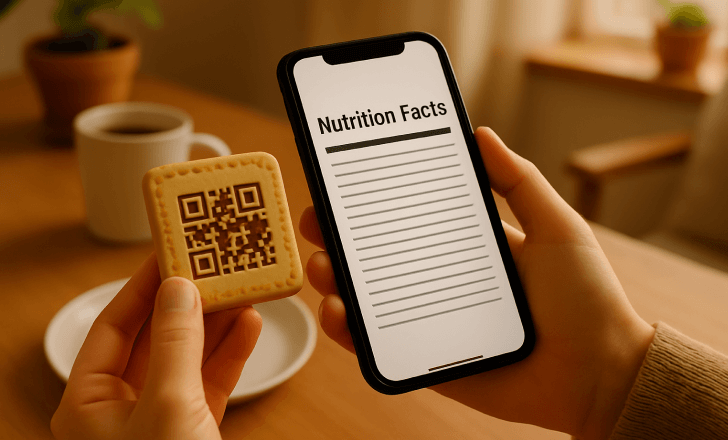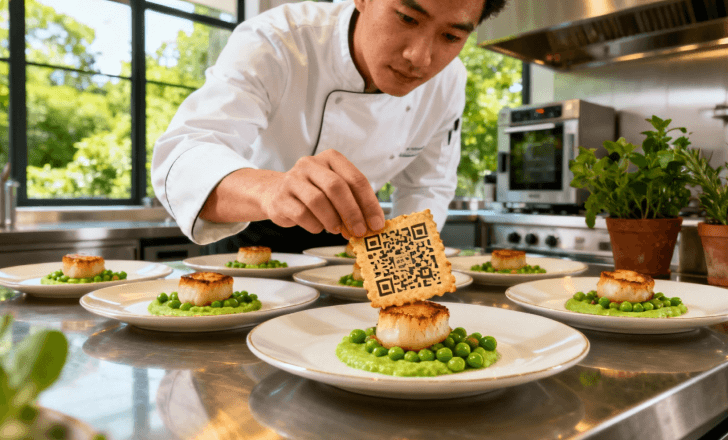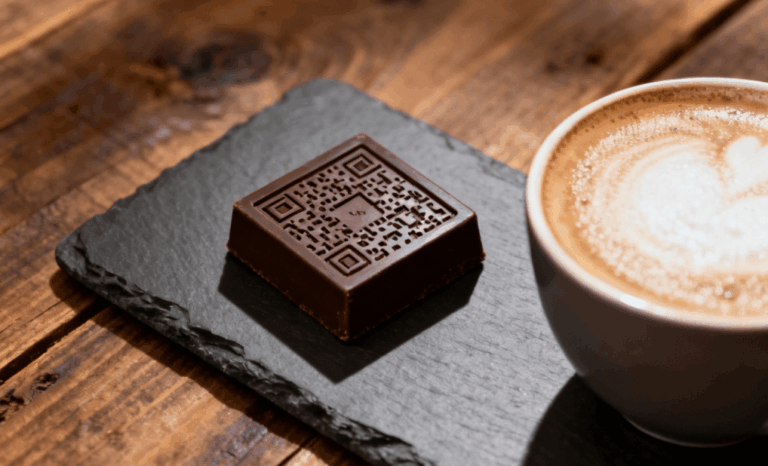The idea of an edible QR code sounds like something out of science fiction, but it’s quickly becoming a reality. Researchers and food technology innovators are developing edible food tags that not only ensure food traceability but also add a new dimension to how we interact with what we eat. From ensuring food safety to creating novel food experiences, these edible tags are opening an entirely new chapter in the digital transformation of the food industry.
What is an edible QR code?
An edible QR code is a scannable matrix code made with non-toxic, digestible materials such as fluorescent silk proteins. These edible tags can be printed directly onto foods or integrated within edible objects, allowing automatic identification without adding extra packaging. Once scanned with a smartphone app, they can display traceability data, nutritional details, or even augmented reality content for interactive food experiences.

How are edible food tags developed?
Developing edible food tags involves advanced printing methods and biotechnological materials. A great example is the research conducted at Osaka University, where a team developed ways to embed edible information using fluorescent silk proteins. These specialized silkworms produce silk that naturally glows under certain light frequencies, enabling the creation of edible QR codes that become visible when exposed to specific wavelengths.
Why is this innovation important for food traceability?
Food traceability has long been a challenge for the industry. Traditional methods such as radio frequency identification tags and secondary packaging level protections often require non-edible materials or extra labeling. Edible QR codes solve this problem by embedding traceability directly into the product. This method helps reduce waste worldwide and eliminates the need for extra packaging while improving the transparency of food supply chains.
Can edible QR codes improve food safety?
Yes. One of the most promising aspects of edible QR codes is their potential role in combating counterfeit medicines and fake drugs, especially in liquid medicines and online pharmacies. By embedding edible information that verifies authenticity, such technologies could provide a powerful new security measure in both the food and pharmaceutical industries. Similar techniques could be used in the alcohol industry to prevent fraud or contamination.
How does the printing method work?
The printing method used to develop edible QR codes typically involves 3D printing or micro-patterning techniques. The team at Osaka University wanted to ensure that the dynamic QR code becomes visible only under certain light conditions, maintaining the food’s outer appearance. This unobtrusive edible tag is a major advantage because it doesn’t alter the food’s flavor, texture, or visual appeal. The edible code is simply contained inside the product, ready to be revealed when needed.

What materials make edible QR codes safe to eat?
Edible QR codes are made using non-toxic, food-grade materials. Fluorescent silk proteins derived from silk cocoons are among the most promising substances. They are biocompatible, safe for ingestion, and can survive common cooking processes. Research teams in agricultural sciences and biomedical engineering are also experimenting with other organic compounds to improve stability and taste neutrality.
What role do universities play in developing edible tags?
Innovative universities like Osaka University, Purdue University, and the National Institute of Agricultural Sciences are leading this field. The lead author of one study, Yamato Miyatake, explained that the team developed a new method of embedding edible information without relying on electromagnetic fields or secondary packaging. Their research combines biotechnology with digital identification standards, setting the foundation for widespread adoption in the future.
Could edible tags enhance food experiences?
Absolutely. Beyond traceability and safety, edible QR codes can create entirely new ways to interact with food. Imagine scanning a dessert to reveal its recipe in augmented reality, or a cocktail whose QR code unlocks a story about its origin. These novel food experiences are transforming the act of eating into a digital interaction that connects consumers, producers, and brands in a more engaging way.

How can edible codes help reduce waste?
Since edible QR codes eliminate the need for additional packaging or separate labels, they contribute directly to waste reduction. This aligns with the global movement toward sustainable production methods and responsible consumption. By embedding information within the product itself, edible tags represent a perfect fusion of technology and environmental responsibility.
Are edible QR codes ready for commercial use?
While the concept is still in development, numerous examples suggest that commercialization is not far off. The production methods are scalable, the materials are affordable, and the results are compatible with existing QR code scanning technology. As more research teams and innovative universities refine the process, widespread adoption across the food industry seems inevitable.

What does this mean for the future of the food industry?
The introduction of edible QR codes could redefine the future of food safety, labeling, and marketing. By merging science, technology, and gastronomy, these codes can turn ordinary meals into interactive, traceable, and sustainable experiences. For food brands, it’s a major step toward digital transformation, one where transparency, safety, and creativity go hand in hand.
A cookie-filled future ahead
The edible QR revolution is just beginning. From counterfeit prevention to immersive dining experiences, the applications of edible food tags span across industries. The world’s leading researchers and food companies are now working toward a cookie-filled future where every bite could tell a story, carry a guarantee of safety, and bring the digital world a little closer to our plate.
